Dehydrated Chicken Strips | How I Make and Store Them
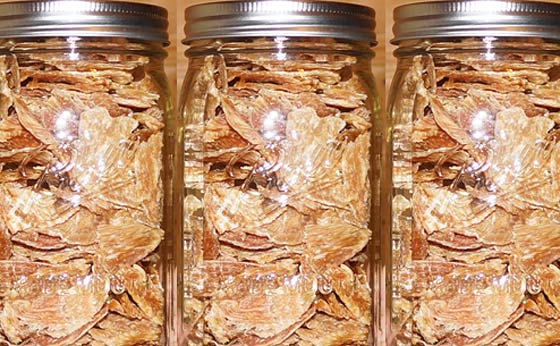
I recently came across a jar of dehydrated chicken strips from a batch made several years ago. I sampled it, and am happy to report they were delicious! Proof that shelf life can be long, if dehydrated and stored properly (details below).
Here’s how I make dehydrated chicken strips:
UPDATED (Safety Guidelines)
Tip: The dehydrator that we use is the Excalibur. It will reach the proper temperature for doing this. Many others will not.
Excalibur Food Dehydrator
(view on amzn)
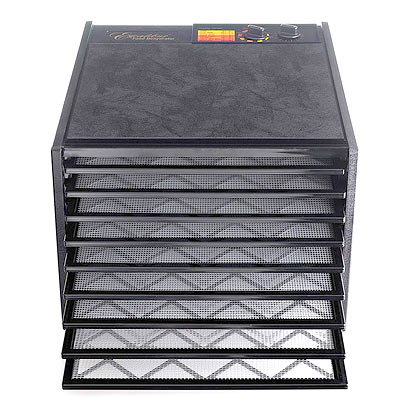
How I Make Dehydrated Chicken Strips
Use Chicken Breast
It’s better to use chicken breast rather than dark meat. That’s because the dark meat has more fat in it and will spoil more quickly than the breast meat.
I recently used chicken breast that was still ‘on the bone’ (because it was on sale). I simply sliced the meat off the bone with a sharp knife.
Having a very sharp knife is important!
Trim All Fat
Important! The next step is to trim away all skin and fat from the meat. Why? Because the fat will go rancid over time if you leave it on. Even after dehydrating the chicken.
As you can see in the picture, I simply used a cutting board, a sharp knife, and kept a bowl nearby to throw in the fatty pieces of meat.
I discarded the skin but saved the fatty pieces of trimmed chicken to cook them separately for immediate consumption by our mini-Dachshund ;) – less waste that way…
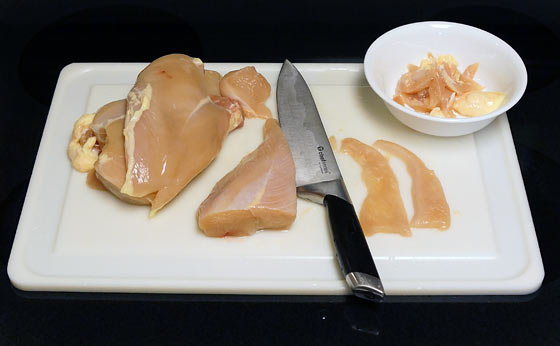
Slice Thin 1/4 Inch Strips
I sliced the meat into strips about 1/4-inch thick. If you cut with the grain, the result will be a slightly more chewy meat. If you cut across the grain, the dehydrated result will snap easier into small pieces. It depends what you want.
Tip: If you partially freeze the chicken, it is easier to cut the strips to a consistent thickness because it’s firmer.
Dehydrator Temperature
I then placed the chicken strips on my dehydrator trays and set the dehydrator temperature to it’s max setting, 165 degrees-F. Lesser temperatures will not be safe. Not all dehydrators can do this.
This is THE most popular dehydrator cookbook:
The Ultimate Dehydrator Cookbook
(view on amzn)

Safety Guideline Update
First, I’ve done it this way for awhile without issue. That is, placing raw chicken strips on trays and dehydrating at the highest temperature setting (165 degrees-F) until done. HOWEVER, some dehydrators don’t get hot enough for meats. Additionally, the USDA has released guidelines for safety in this regard. Here’s the present recommendation:
“Steam or roast meat to 160 °F and poultry to 165 °F as measured with a food thermometer before dehydrating it.”
Safety concerns related to E. coli O157:H7 are minimized if the chicken is precooked to 165 °F prior to drying.
Therefore I recommend placing your cut chicken strips in a appropriate baking pan. Set oven temperature to a low setting so as not to “cook”. You just want to heat the strips up up to at least 165 °F. So, an oven temp of say, 275 °F (time will vary depending on your oven and strip thickness). Go ahead and heat the chicken and periodically check internal meat temperature with a quick-read thermometer until at least 165 °F.
Then you can place on dehydrator trays:
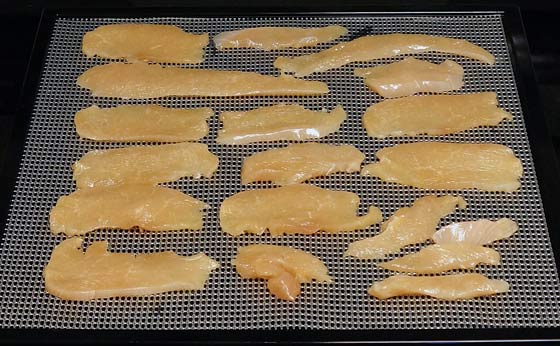
How Long To Dehydrate Chicken
Dehydrate the chicken strips until they at least reach a leathery consistency. Personally I like to dry them longer until they’re very crisp. This way they’re drier and they will last longer.
The dehydrate time will vary quite widely, depending on thickness of the chicken strips, your environmental conditions, the dehydrator itself, temperature, and how dry that you want them. This could vary anywhere from 6 to 12 hours!
Plan on starting this process in the morning so that you won’t run out of time before having to call it a night and go to bed…

After the chicken strips have finished dehydrating, I break them up into smaller pieces. This way they fit into canning jars which I sealed with a vacuum sealer ‘jar sealer’ attachment.
How Long Does Dehydrated Chicken Last?
Predicting how long dehydrated foods will last is not exact. Why? Because there are lots of variables including the final moisture content, storage temperature, method, oxygen content and more…
TIP: Shelf life will be significantly longer if foods are dehydrated to crisp and brittle. When they “snap” while breaking. With that said, somewhere between being somewhat pliable and crisp is a preferred doneness for some.
We often store our various home dehydrated foods in canning jars. We vacuum seal them with a Jar Sealer attachment, an accessory for vacuum sealers having an external hose port.
Vacuum sealed greatly enhances the shelf life!
Food Saver Vacuum Sealer
(view on amzn)
[ Read: Things You Can Seal With A Vacuum Sealer ]
Here’s a picture of a ‘canning jar’ filled with dehydrated chicken strips:
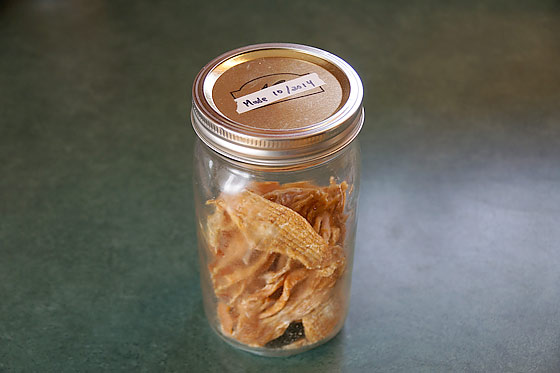
[ Read: 4 Factors That Affect Dehydrated Food Shelf Life ]
I cannot advise an accurate number for shelf life. I can tell you that I’ve eaten well dehydrated chicken strips several years afterwards (stored in vacuum sealed jar in a cool, dark environment). But yours might only last 2 months. It’s going to depend.
The thing is, It’s difficult to test the actual shelf life because these things disappear (consumed!) sooner rather than later…
[ Read: Safe Jerky In A Home Dehydrator ]
